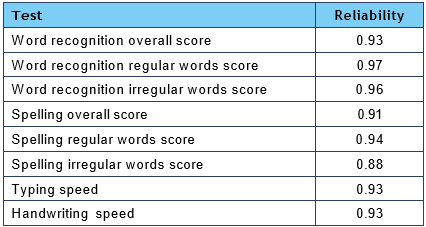Reliability of Exact
‘Reliability’ generally refers to the extent to which a test can be expected to give the same results when administered on a different occasion (test-retest reliability) or by a different administrator (inter-rater reliability), or to which the components of a test give consistent results (internal consistency). Note that this is not the same as the validity of the test (see Validity of Exact).
Table 3. Reliability coefficients (Cronbach’s alpha) for four of the tests in Exact show the coefficients of reliability for each of the Exact tests, calculated using Cronbach’s alpha statistic, which is a measure of the internal test consistency. Reading Comprehension results are not included here because this subtest has been updated since this study was completed. Note that the reliability coefficients shown in the table are all high (around 0.9). These results show that all the tests in Exact have satisfactory reliability.
Although test-retest reliability is frequently quoted in test manuals, this measure is problematic because students are likely to remember items and answers from the previous assessment, which results in confounding memory factors. However, since Exact comprises two parallel forms, these can be compared in a test-retest situation, which is arguably a more satisfactory method of checking the test reliability since the test content is different in the two forms. To achieve this, Exact spelling test data was collected from a total of 373 students aged 11-16 attending a large secondary academy in South London. The test-retest correlation coefficient over a period of six months was 0.757, these results all being statistically significant at p<0.001. (Word recognition and writing/typing to dictation were not tested in this project.)
Table 3. Reliability coefficients (Cronbach’s alpha) for the tests in Exact


